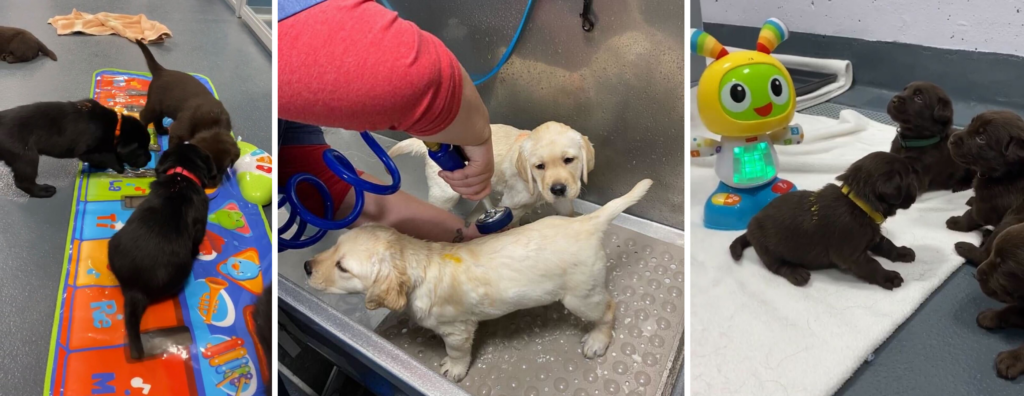The Puppy Pathway to service dog success

Milestone 2: Nursery Time
In this ongoing series, we’re exploring each milestone along the Puppy Pathway, a journey of growth, learning, and rewards for puppies in FSD’s assistance dog training program. This month, we’ll look at Milestone 2: Nursery Time (birth to 8 weeks old).
The first eight weeks in a puppy’s life are crucial to their physical and neurological health. During this time, FSD employs early neurological stimulation (ENS), early exposure, socialization, and health care protocols to ensure they have the best possible chance for service dog success.

Our puppies receive exceptional care from the moment they are born under the watchful eyes of our health and reproduction teams. For their first eight weeks, our newborns are housed in the nursery, which is specially designed to provide a safe and sterile environment until the pups are fully vaccinated.
During week one, the pups (along with their mother) are monitored 24/7 by staff and volunteers to ensure their safety and well-being. At this point, the pups’ eyes and ears are not open, and they cannot regulate body temperature. They can only nurse and move toward and away from a heat source.

After the first two critical weeks of life, the pups develop quickly. Their eyes and ears open, and they encounter their first sights and sounds. From day three to day 16, we provide early neurological stimulation to all our newborns. Developed for military working dogs, ENS gently and progressively stimulates a stress response in puppies. This process has been scientifically proven to help puppies learn that they can recover from stressful events. It also supports future cardiac and respiratory health, leads to faster maturation, and improves problem-solving skills later in life.
Body handling is one of the key elements of ENS, and after week one, our pups receive body handling every day. We hold them upright for three seconds, head-down for three seconds, and cradled on their back for three seconds. Next, we have them stand on a cold, wet washcloth for three seconds and then tickle their feet with a cotton swab for three seconds. We touch their ears, neck, head, legs, and feet, and we cut their toenails weekly so they get accustomed to nail trims, which makes life easier for future puppy raisers, veterinarians, and clients.
On day seven or when the pups are strong enough, we introduce them to wearing tiny collars. On day 21, they start wearing sweaters, along with hair scrunchies on their paws, before progressing to miniature service dog vests. We connect the vests with positive, pleasurable rewards so they will be comfortable wearing a vest on a daily basis as adult service dogs.

Once the pups can hear, we play different sounds for them each day: babies crying, airport and hospital noises, sirens, kids playing, a cruise ship horn, dogs barking, farm animals, doorbells, knocks, and more. By exposing puppies to these sounds at a very young age, they will recognize them later in life and not be afraid of them.
Since our pups can’t leave the nursery before 8 weeks of age, we bring all types of walking surfaces to them (sanitized, of course!). By stepping on uneven, unstable items like bubble wrap, wicker, carpet, tiles, cookie sheets, and other objects, our pups learn to engage their muscles and walk confidently on a variety of surfaces. Every moment is a learning moment for these puppies with a purpose!

Up next: Learn about our pups’ first formal training during Kindergarten in the March Pupdate e-newsletter. Subscribe to receive monthly Pupdates!
Contact Erin Conley at econley@

